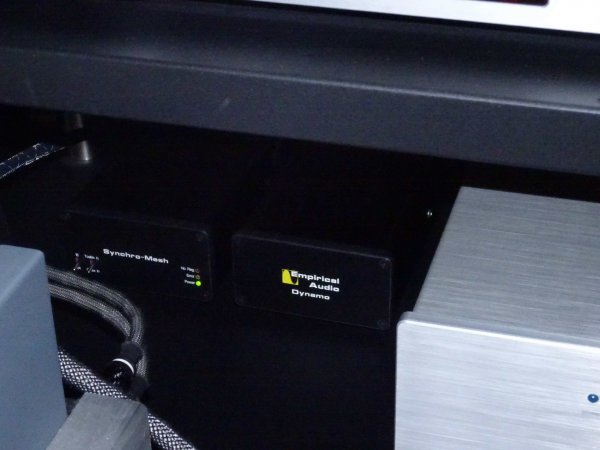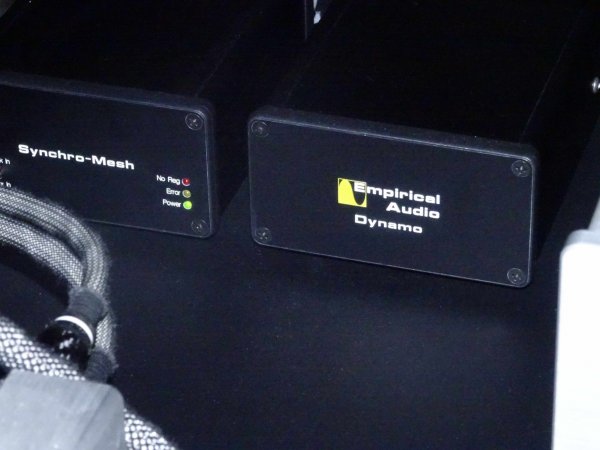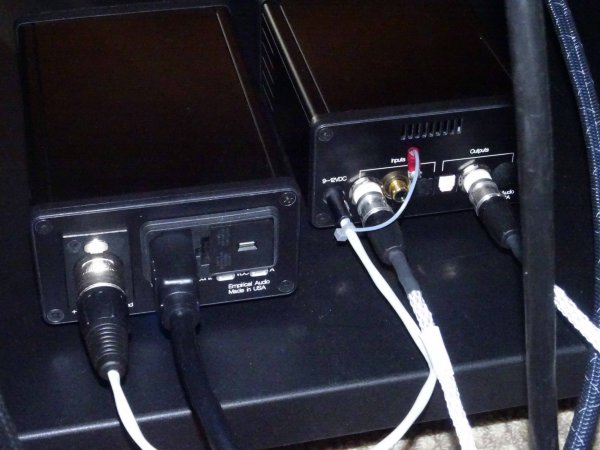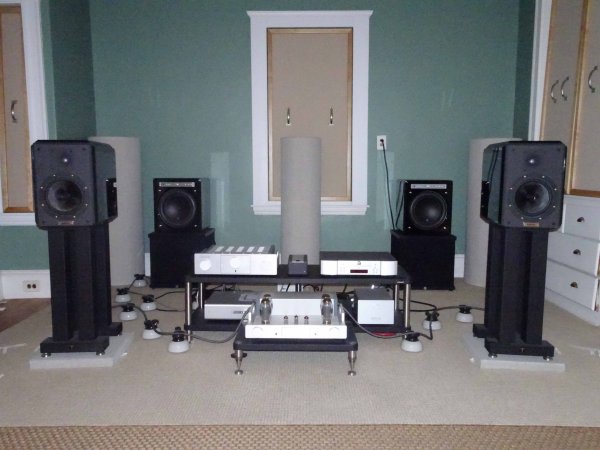
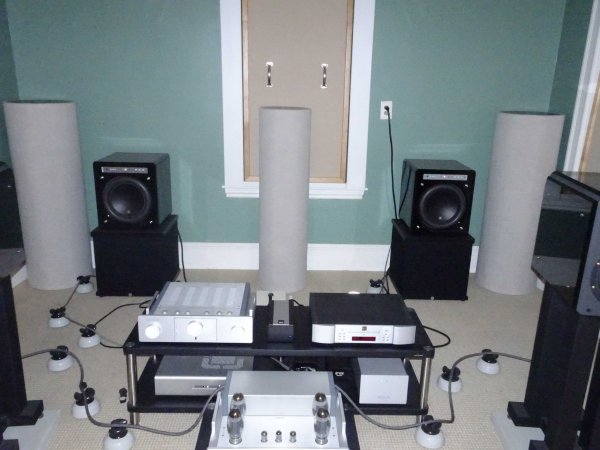 Partial removal/shuffling of TubeTraps
Partial removal/shuffling of TubeTraps
Given that I had already been experimenting with acoustic treatments, last week I was thinking what would happen with the removal of some TubeTraps. In particular, I was wondering if the large TubeTrap array was removing some midbass energy that could be restored. In the end I arrived at what is seen above in the photos. The two 13 inch TubeTraps on top of the 16 inch TubeTraps, see:
https://www.whatsbestforum.com/threads/my-monitor-subwoofer-system.25101/#post-501698
are removed from there. Two 16 inch TubeTraps, forming a middle column behind the now also removed absorbing panel, are removed as well. In their place is now one of the 13 inch TubeTraps. The corners still carry single 16 inch TubeTraps. Initially I kept them with their diffusive side turned outward, as I had them before.
Result:
Basically no effect:
1. Midbass energy hardly changed, which was a bit of a surprise.
2. Imaging on some critical recordings is still upfront where it should be, such as on the vocals on my reference rock tracks.
3. There is no obvious decline of the excellent rhythm & timing that I have. It greatly deteriorated previously when ALL TubeTraps were removed.
Positives:
4. There is yet more air in the presentation, and surprisingly, also more effortlessness, in the sense that there seem to be fewer distortions, which normally might be attributed to loudspeaker strain. For some reason, the effect is not unlike moving the speakers closer together in order to avoid distortions from sidewall reflections. The music feels that it sounds a bit more "open", transparent and real, even though perceived HF extension did not improve dramatically, only perhaps slightly.
5. There appears to be more perceived width at the front of the soundstage on some recordings, and orchestral width seems largely restored from what it was prior to recently moving the speakers closer together.
As for point 2., I also checked on the powerful rock classic "Hells Bells" by AC/DC. That track features a somewhat recessed image of the singer (not just on my system), but it became instantly better, moving more forward, as I turned the middle TubeTrap from the diffusive to the absorptive side, keeping the corner TubeTraps with the diffusive side pointing outward as they had been.
Yet while I heard all the positives under points 4 and 5, playing more and more tracks also revealed some negatives. The trumpet of Lee Morgan on 'Twilight Mist' from the album 'Tomcat' (XRCD) became a bit less solid sounding, also with less color, and dynamic impact was diminished. Other trumpet tracks were less affected.
The violin of Hilary Hahn on her exciting album 'Encores', with encores commissioned by her personally from 27 contemporary composers, has timbres that can be a bit tricky to reproduce, but now sounded as natural as I have heard. Yet the accompanying piano sounded a bit more diffuse and muddled than I would have liked to hear. There was more portrayal of a reverberance of the recorded acoustic, but it did not substantially affect perceived incisiveness of transients on violin. Yet that unfortunately happened with the violin on Rachel Barton Pine's incredible interpretation of Bach's partitas and sonatas for solo violin. There was also a noticeable flattening of dynamics and of tone, which lost some of its attractive woodenness. The recording had sounded quite dry before, and now there appeared a reverberant acoustic, as would seem appropriate given that the music was recorded in a church (St. Paul's Church in Chicago), but impact was diminished to an uncomfortable extent.
Fortunately, all the negatives went away, either largely or completely, when I then turned the corner TubeTraps so that the absorptive side, rather than the diffusive side, pointed outward (I love this versatility of TubeTraps). The acoustic on the violin recordings by Hilary Hahn and Rachel Barton Pine became dryer again, yet not as dry as before with all the TubeTraps in place, and incisiveness of transients on the violin on the latter recording returned to a satisfying degree. Dynamics and variation of tone seemed intact again. The piano playing alongside Hilary Hahn's violin regained clarity. The trumpet of Lee Morgan on 'Twilight Mist' regained its earthy and more incisive, dynamic tone.
As I said above, after rearrangement of the TubeTraps the upfront character of imaging on a number of critical recordings, where I would lament a change, was preserved. Yet on some others there was a bit more of a recession of imaging than I would like. With turning the corner TubeTraps to the absorptive side facing outward this is largely reversed.
All in all, the removal of some TubeTraps and tweaking the absorptive/diffusive character of the remaining ones, had a clear net positive effect, with very minor drawbacks.
All this shows how delicately the perceived performance of a system, even in terms of transient behavior and dynamics, depends on room acoustics, especially with cone speakers with their broader dispersion characteristics (electrostats and horns may be affected less). I was already operating within a good window of room acoustics, given all the other acoustic treatments in place, and was just tweaking within that range by TubeTrap removal/shuffling. But what if you are outside that range in the first place? The system performance clearly will be below what it should be. Those who ignore working on their room acoustics do so at their own peril, unless they happen to have an almost ideal room to start with, which in my experience is rarely the case. If living circumstances exclude more intrusive room treatments, at least experimenting with carpets (type/location) and furniture placement may be worthwhile.




